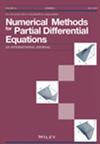具有残差一致粘度的欧拉方程的显式四阶混合变量法
IF 1.7
3区 数学
Q1 MATHEMATICS, APPLIED
引用次数: 0
摘要
在本文中,我们在线性方法的背景下提出了一种正式的四阶精确欧拉方程混合变量(HV)方法。HV 方法寻求单元平均值和节点解的数值近似,并同时对它们进行时间演化;前人的工作证明了这些方法具有超收敛性,即方法的阶数高于局部截断误差的阶数。利用超收敛性的优势,该方法建立在三阶离散微分算子的基础上,该算子仅利用相邻两个单元的信息来逼近每个网格点的一阶空间导数。在线性平流方程的一维情况下,对稳定性、准确性和点收敛性进行了分析;而在包括欧拉方程在内的非线性系统中,则使用特征分解和残差一致粘度来捕捉强不连续性。本文介绍了广泛的数值测试,以评估该方法在一维和二维问题上的数值性能。本文章由计算机程序翻译,如有差异,请以英文原文为准。
An explicit fourth‐order hybrid‐variable method for Euler equations with a residual‐consistent viscosity
In this article, we present a formally fourth‐order accurate hybrid‐variable (HV) method for the Euler equations in the context of method of lines. The HV method seeks numerical approximations to both cell averages and nodal solutions and evolves them in time simultaneously; and it is proved in previous work that these methods are supraconvergent, that is, the order of the method is higher than that of the local truncation error. Taking advantage of the supraconvergence, the method is built on a third‐order discrete differential operator, which approximates the first spatial derivative at each grid point using only the information in the two neighboring cells. Analyses of stability, accuracy, and pointwise convergence are conducted in the one‐dimensional case for the linear advection equation; whereas extension to nonlinear systems including the Euler equations is achieved using characteristic decomposition and the incorporation of a residual‐consistent viscosity to capture strong discontinuities. Extensive numerical tests are presented to assess the numerical performance of the method for both 1D and 2D problems.
求助全文
通过发布文献求助,成功后即可免费获取论文全文。
去求助
来源期刊
CiteScore
7.20
自引率
2.60%
发文量
81
审稿时长
9 months
期刊介绍:
An international journal that aims to cover research into the development and analysis of new methods for the numerical solution of partial differential equations, it is intended that it be readily readable by and directed to a broad spectrum of researchers into numerical methods for partial differential equations throughout science and engineering. The numerical methods and techniques themselves are emphasized rather than the specific applications. The Journal seeks to be interdisciplinary, while retaining the common thread of applied numerical analysis.

 求助内容:
求助内容: 应助结果提醒方式:
应助结果提醒方式:


